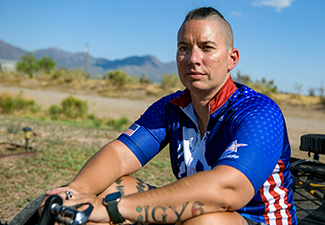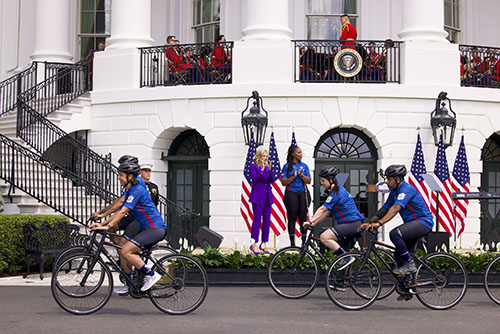Soldier Ride: A Life-Changing Journey
Since 2004, Soldier Ride® has evolved from a lone rider on a mission to a program that serves approximately 2,000 veterans and their families annually. The nationally recognized adaptive cycling event has become one of the most successful programs at Wounded Warrior Project® (WWP). Soldier Ride not only fosters warrior connection and community engagement but it also invites the American public to pay tribute to their service and sacrifice.
“I’ve been blessed to not only ride alongside some of these amazing men and women but also hear some of their successes and stories,” said James Herrera, WWP Physical Health & Wellness vice president. “Our goal is to provide a long-term path to recovery for every warrior through movement. Wherever veterans are in their recoveries—whether from visible or invisible wounds such as stress, depression, or PTSD—we are here to support them every step of the way.”
Over the last 20 years, Soldier Ride has offered over 17,000 opportunities to warriors since its inception, leaving a lasting, restorative impact on countless veterans and service members.
How Soldier Ride Got Started
It was 2004 and Chris Carney had his eyes set on a mission; ride his bike from coast to coast to help raise awareness for injured veterans while supporting WWP. Carney, a Long Island native and longtime veteran supporter, was inspired by the story of U.S. Army veteran John Fernandez. A fellow Long Islander, John lost his left foot and right leg below the knee during a deployment in the early days of Operation Iraqi Freedom. John quickly became the inspiration for a local fundraiser in his community, which evolved into the first coast-to-coast bicycle ride by Carney, who cycled more than 5,000 miles across the country.
The following year, several combat warriors who returned from Operation Enduring Freedom joined Carney for another cross-country ride. The trek across the nation proved to be a milestone on the journey to recovery as wounded warriors redefined their strengths and limitations. They used the experience as a catalyst to show the public — and themselves — that with support and motivation, anything was possible. With the support of his community and WWP, John cycled his first Soldier Ride in 2006, just three years after sustaining his injuries.
Evolving to Meet Warrior’s Needs
In the years that followed, WWP enhanced the Soldier Ride program to meet a more diverse set of needs of wounded veterans. Recognizing the growth in women warriors, Soldier Ride added women-only events. The program also now includes a variety of ride options to serve warriors. These include traditional and adaptive road biking, mountain biking, skiing, snowboarding, training challenges, and skills development camps. In 2020, Soldier Ride launched virtual programming due to the pandemic. Warriors worldwide could connect online with WWP's cycling community, partake in riding challenges, and meet for virtual coffee socials. The combination of virtual and in-person programs helps reach warriors at different points in their recovery journey.
Soldier Ride is not just physical rehabilitation. As this generation of injured veterans ages, their evolving and often unseen needs will become more apparent. Many warriors suffer in silence. Soldier Ride provides warriors an opportunity to build healthy social connections, known to reduce suicide risk and improve the management of stress, anxiety, and depression. Rediscovering a sense of camaraderie among fellow warriors is as important to the Soldier Ride experience as the ride itself. The likelihood of experiencing post-traumatic stress disorder (PTSD) symptoms is 57% lower among warriors who maintain social support from military friends, according to WWP’s 2022 Annual Warrior Survey.
Even though Soldier Ride has changed over time, the foundation remains: Warriors don’t ride alone on this mission – they move forward together as a unit, just like they did during their military service. Soldier Ride equips warriors to enjoy the mental and physical benefits of cycling for years to come. Warriors who adopt healthier habits see improvements in chronic conditions, their mental wellness, and an increase in overall quality of life.
Soldier Ride empowers veterans to find support, recovery, and strength through movement. Wounded veterans who participate in Soldier Ride discover it is not just an activity – it is a life-changing opportunity to find healing in both mind and body.
What Warriors Are Saying About Soldier Ride
Contact: Krissty Little - Public Relations, klittle@woundedwarriorproject.org, 904.760.6957
About Wounded Warrior Project
Since 2003, Wounded Warrior Project® (WWP) has been meeting the growing needs of warriors, their families, and caregivers — helping them achieve their highest ambition. Learn more.



